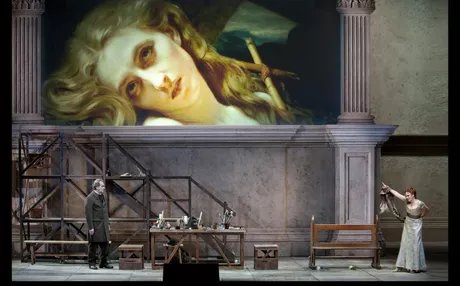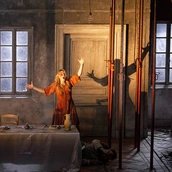
MELODRAMA IN THREE ACTS (1900)
When the revolutionary-minded painter Mario Cavaradossi tries secretly to help a politically persecuted man escape his mistress, the famous singer Floria Tosca, he deceives her with another woman. The unscrupulous policeman Scarpia uses her jealousy to convict Cavaradossi and then demands a night with Tosca in return for the liberation of her lover.
With a stringent dramaturgy and distinctive realism, Puccini created one of his most powerful and dramatic works - a milestone in opera history.
In the context of the conflict between Napoleon's Revolutionary Army and the Habsburg-papal troops in 1800, which became the protagonist of the opera, Puccini whispered audiences to the center of Rome: the Church of Sant'Andrea della Valle, the Palazzo Farnese and the Engels, to whom the composer gave his own musical color. In the production of the Latvian actress Alvis Hermanis, the singers move in a psychologically dense narrative, transposed into the era of the opera around 1900.
The scenic representation is supplemented by a elaborately designed graphic novel by the stage and costume designer Kristine Jurjane the original works of the 17th and 18th of June 1800 in Rome and projected onto a stage of monumental representation architecture.
- Duration: about 2:30 h including an intermission after the 1st act.
- Language: In Italian with German and English surtitles
- Age recommendation: from 12 years
Additional information
ACT ONE
Inside the church of Sant’Andrea della Valle
Cesare Angelotti, a former consul of the Roman Republic and now a political prisoner on the run, has fled from the Castel Sant’Angelo to the church Sant’Andrea della Valle. His sister, the Marquesa Attavanti, had hidden a key to the family chapel for him, where women’s clothing is hidden to help him on his flight. Mario Cavaradossi, a young painter, is working in the church on a painting of Mary Magdalene. The sacristan notes the great likeness between the painting of the saint and the unknown beauty who in recent days has repeatedly come to the church to pray. After expressing his disgust at this to Cavaradossi, who is naturally suspicious to him as a free thinker, the sacristan leaves.
Angelotti steps out of the family chapel. Cavaradossi recognizes the former consul, who has to hide immediately thereafter, because Floria Tosca, a singer and lover of Cavaradossi, demands entrance to the church. Tosca thinks she recognizes in Cavaradossi’s painting a likeness to the Marquesa Attavanti. It is only with great difficulty that Cavaradossi is able to calm Tosca’s jealousy. She asks Cavaradossi to pick her up that evening after the opera performance and to spend the night with her in his country residence. Cavaradossi agrees. Once again alone, he offers Angelotti his help. A cannon shot sounds out from the Castel Sant’Angelo: Angelotti’s escape has been discovered. Immediately, Cavaradossi rushes with Angelotti to his country home, where Angelotti can hide in the garden well.
Overly confident, the sacristan and choristers rush into the now empty church. At that very moment, news spreads of the defeat of Napoleon in the battle of Marengo. The celebrations end abruptly after the appearance of the police chief Scarpia and his henchmen in search of Angelotti. Scarpia’s men find a basket of food and Attavanti’s fan. Quickly, Scarpia reconstructs the story on the basis of the information provided by the sacristan. When Tosca returns to the church to cancel her evening meeting with Cavaradossi because she has to sing at the royal victory ceremony, Scarpia is able to enflame the jealousy of the diva using the found fan.
Furious, Tosca makes her way to Cavaradossi’s country residence, where she thinks she will find him with Attavanti. Scarpia commissions his underling Spoletta to follow Tosca unseen. At the sound of the Te Deum, Scarpia’s sadistic desires reach untold limits: he sees the rebel on the gallows, the singer in his arms.
ACT TWO
Scarpia’s office at Palazzo Farnese
Scarpia awaits his minions, while at the palace banquet hall the defeat of Napoleon is celebrated. Spoletta commissions the policeman Sciarrone to give Tosca a message with the command to come to him after her performance at the victory celebration. At the same time, he has Cavaradossi summoned, but the painter refuses to betray the location of Angelotti’s hiding place. In response, Scarpia has the artist tortured in the presence of Tosca, who has now arrived. Cavaradossi remains stubbornly silent, but Tosca cannot bear the torture of her lover, and reveals Angelotti’s hiding place. Sciarrone appears and announces that the news from the afternoon was in fact wrong: Napoleon has won after all! While Cavaradossi joyfully greets the unforeseen turn of events, Scarpia orders the execution of the painter. At the same time, he makes it clear to Tosca that the death of the painter could only be avoided if she surrenders herself to him. Her begging for mercy fires his obsession even more.
The news of Angelotti’s suicide and the approaching execution of Cavaradossi finally breaks Tosca’s resistance. The diva is ready to give in to Scarpia’s demands. In the presence of Tosca, he orders a fake execution of Cavaradossi the next morning with unloaded weapons. Finally Tosca demands free passage for the artist and for herself. After Scarpia signs the document, Tosca picks up a knife and stabs Scarpia to death.
ACT THREE
On a platform at Castel Sant’Angelo
In the morning gray, Cavaradossi awaits his execution at Castel Sant’Angelo. In despair, he tries to write a letter of farewell to Tosca. She appears and tells him of the murder of Scarpia and that he, Cavaradossi, will be free and will only be shot for the sake of appearances with unloaded weapons. The couple dreams of a happy life together.
The soldiers arrive, and the execution takes place as planned. When Tosca tries to get her lover to get up after they leave, she realizes that Scarpia has cheated her: Cavaradossi is dead. Voices are heard: Scarpia’s murder has been discovered. Before she can be caught by Spoletta, Tosca leaps to her death.
Participating artists
Saioa Hernández
Fabio Sartori
Ambrogio Maestri
Grigory Shkarupa
Jan Martiník
Florian Hoffmann
Carles Pachon
Benjamin Chamandy



